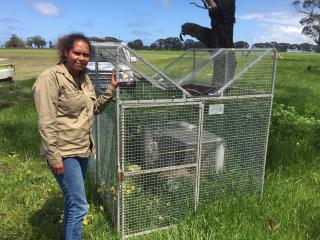Western Australia’s annual pest starling surveillance and management program on the WA/South Australian border and south coast has been complemented over recent months with local community involvement.
The Department of Primary Industries and Regional Development has employed Esperance Tjaltjraak Native Title Aboriginal Corporation Rangers to assist biosecurity officers in starling trapping east of Esperance.
Department biosecurity officer Darren Dixon said the common starling (Sturnus vulgaris) was an invasive bird pest which had established in many countries outside its natural range of Europe, Asia and North Africa.
“Starlings feed on cultivated grain and horticultural crops, disperse weeds, foul wool and can displace native birds,” Mr Dixon said.
“Since 1971, the department has run an ongoing trapping and surveillance program in the south-east of the State to prevent the encroachment of the pest birds from South Australia, where this introduced pest has established.
“The employment of Tjaltjraak rangers has enabled enhanced trapping over the October to December period to coincide with the fledgling of juvenile starlings.”
Over the past 10 years, the average number of starlings trapped in Eucla has been from 42 to 45, with 161 trapped last season.
Mr Dixon said since August 2018, 55 starlings had been trapped at Eucla, indicating the 2018/19 season was likely to yield a higher than average result, prompting the placement of 72 traps from west of Hopetoun to east of Condingup, across 7,000km2.
“Because the threat of starlings into WA is constant, the department recruited and trained Tjaltjraak rangers to undertake trapping using live lure birds at strategic locations near Esperance,” he said.
“Feral animal management is an aspect of the State Government’s Aboriginal Ranger Program to create jobs and training and community development opportunities.”
Starlings are small to medium-sized birds. They have distinctive glossy black feathers with an iridescent green and purple sheen. From a distance they can look plain black.
Young birds, seen mainly in spring and summer, are a mouse-brown colour. When they moult to adult plumage in autumn they have a patchy brown and black appearance, often with some pale spotting.
Community members are encouraged to report any unusual activity, such as birds on the back of livestock or groups of black birds flying in tight groups, particularly in the Munglinup, Hopetoun and Esperance areas.
Reports can be made by using the department’s MyPestGuideTM Reporter app or MyPestGuide online or contact the Pest and Disease Information Service (PaDIS) on +61 (0)8 9368 3080 or email padis@dpird.wa.gov.au.

Media contact: Jodie Thomson/Dionne Tindale, media liaison +61 (0)8 9368 3937
